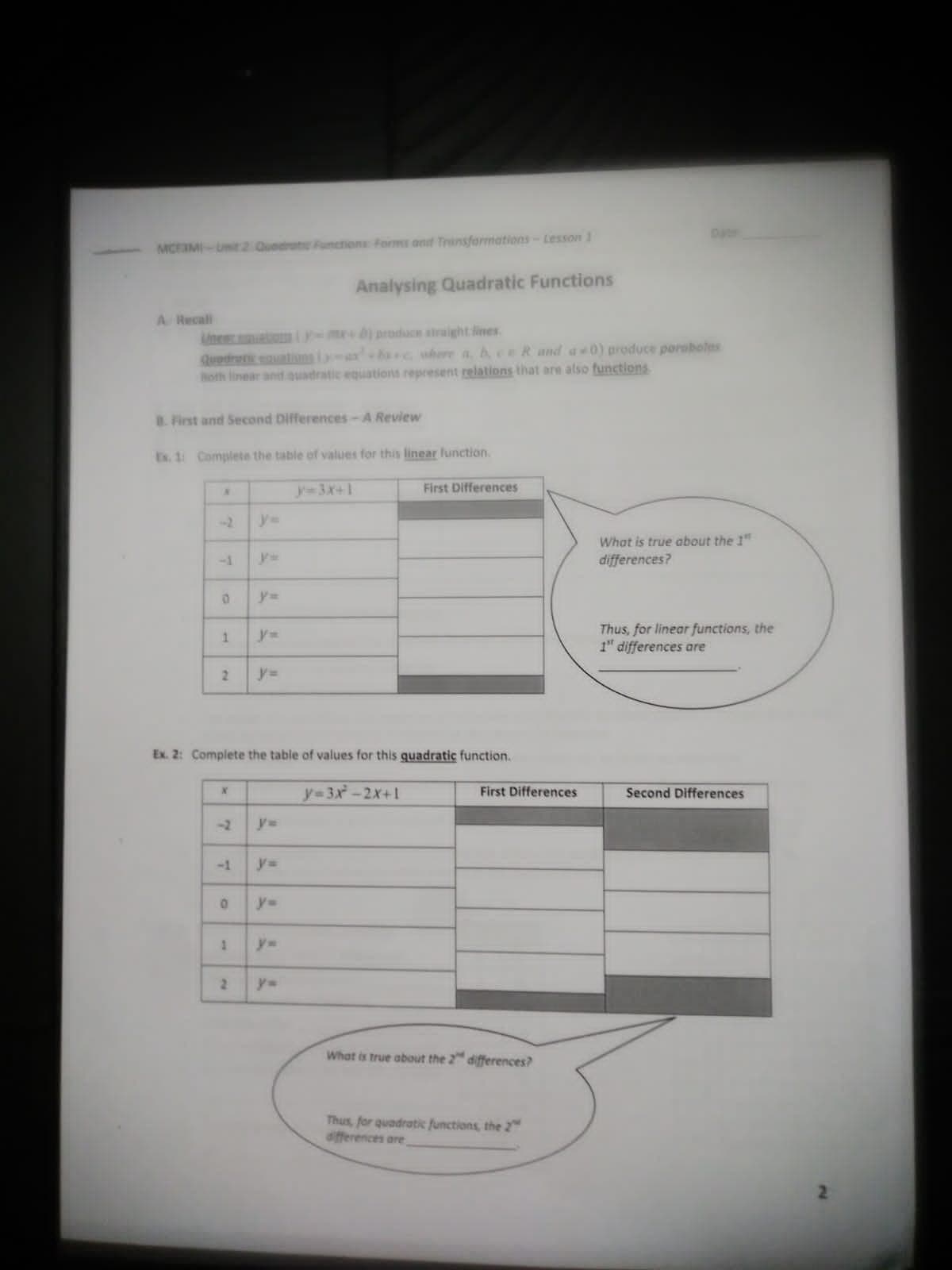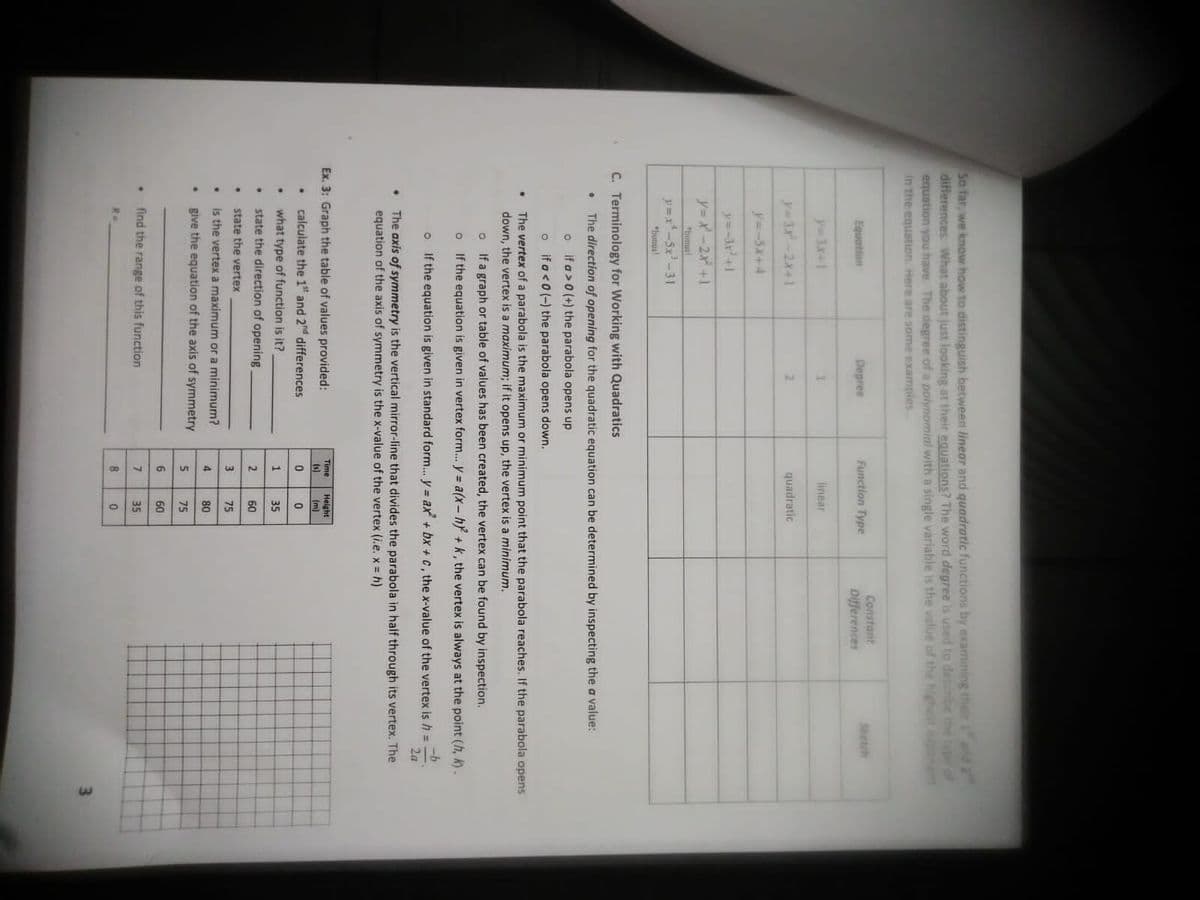Es. 1 Complete the table of values for this linear lunction. y-3x+1 First Differences -2 y%=D What is true about the 1" differences? -1 %3D y%3D Thus, for linear functions, the 1" differences are %3D y%3D 1. 2.
Es. 1 Complete the table of values for this linear lunction. y-3x+1 First Differences -2 y%=D What is true about the 1" differences? -1 %3D y%3D Thus, for linear functions, the 1" differences are %3D y%3D 1. 2.
Algebra & Trigonometry with Analytic Geometry
13th Edition
ISBN:9781133382119
Author:Swokowski
Publisher:Swokowski
Chapter11: Topics From Analytic Geometry
Section11.2: Ellipses
Problem 40E
Related questions
Question

Transcribed Image Text:MCFIMI-Unit 2 Quedrat Functions forms ant Transformations-Lesson 1
Analysing Quadratic Functions
A Recal
inen ato -m b) produce atraight lines
Quodretic enuations i
Both linear and ouadratic equations represent relations that are also functions
bac where a AceR and a0) produce porsboles
B. First and Second Differences-A Review
Es. 1 Complete the table of values for this linear lunction.
y-3X+1
First Differences
y%3=
What is true about the 1"
differences?
-1
y3D
y%3D
Thus, for linear functions, the
1" differences are
1.
y%3D
2.
%3D
Ex. 2: Complete the table of values for this quadratic function.
y-3x-2x+1
First Differences
Second Differences
-2
y%3D
-1
y=
y=
y%3D
What is true about the 2" differences?
Thus, for quadratic functions, the 2
differences are

Transcribed Image Text:So far, we know how to distinguish between linear and quadrotic functions by examining ther
differences What about just looking at their equations? The word degree is used to describe ihe yrof
equation you have The degree of a polynomial with a single variable is the value of the higheit ent
in the equation Here are some examples
Constant
Function Type
Sketch
Equation
Degree
Differences
y=3x+1
linear
y=3x-2x+1
quadratic
y=-5x+4
y=-3r'+1
y= x-2x +1
"boma
y=x-5x-31
mus!
C. Terminology for Working with Quadratics
The direction of opening for the quadratic equation can be determined by inspecting the a value:
o ifa>0 (+) the parabola opens up
if a <0 (-) the parabola opens down.
The vertex of a parabola is the maximum or minimum point that the parabola reaches. If the parabola opens
down, the vertex is a maximum; if it opens up, the vertex is a minimum.
o If a graph or table of values has been created, the vertex can be found by inspection.
If the equation is given in vertex form... y = a(x- hy + k, the vertex is always at the point (h, k).
If the equation is given in standard form.. y = ax + bx + C, the x-value of the vertex is h =
2a
The axis of symmetry is the vertical mirror-line that divides the parabola in half through its vertex. The
equation of the axis of symmetry is the x-value of the vertex (i.e. x = h)
Ex. 3: Graph the table of values provided:
Time
Height
(m)
(s)
calculate the 1“ and 2nd differences
what type of function is it?
35
state the direction of opening
2
60
state the vertex
75
is the vertex a maximum or a minimum?
4
80
give the equation of the axis of symmetry
5
75
6.
60
find the range of this function
7.
35
8.
3.
Expert Solution
This question has been solved!
Explore an expertly crafted, step-by-step solution for a thorough understanding of key concepts.
Step by step
Solved in 2 steps

Recommended textbooks for you

Algebra & Trigonometry with Analytic Geometry
Algebra
ISBN:
9781133382119
Author:
Swokowski
Publisher:
Cengage

Algebra & Trigonometry with Analytic Geometry
Algebra
ISBN:
9781133382119
Author:
Swokowski
Publisher:
Cengage